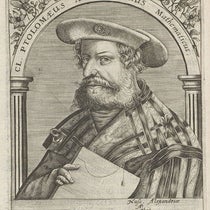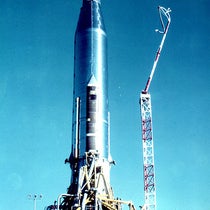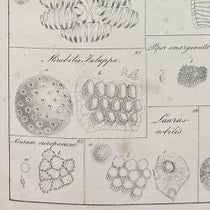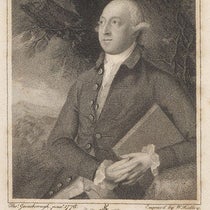Scientist of the Day - Bruno Bearzi

Bronze panel no. 1, based on the title page, Divina proportione, by Luca Pacioli, 1509, with one of Leonardo da Vinci's woodcut polyhedrons added at top; cast by Bruno Bearzi, 1965, north exterior annex wall, Linda Hall Library
Bruno Bearzi, a Florentine foundryman, was born on Nov. 19, 1894, in Palmanova in northeast Italy. Bearzi was one of those responsible for hiding and protecting priceless works of art during World War II, including the three sets of bronze doors for the Baptistery in Florence, made by Andrea Pisano and Lorenzo Ghiberti in the 14th and 15th centuries.
When the doors were returned in 1946, Bearzi realized that 500-year-old East Doors by Ghiberti, known since Michelangelo as the “Doors of Paradise,” were badly corroded and in need of restoration. Having done what he could (the art of bronze restoration was not very sophisticated in the 1940s), he then made plaster casts of the doors, from which gypsum molds were made, which were then archived. At the time, Florentine authorities were not interested in moving the original doors into a museum and replacing the baptistery doors with copies.

Bronze panel no. 2, based on the engraved title page, Novum Organum, by Francis Bacon, 1620; cast by Bruno Bearzi, 1965, north exterior annex wall, Linda Hall Library
Much later, after the Florentine floods of 1966 had further damaged the Doors of Paradise, it was decided to make replacement doors. A donor was found for this multi- million-dollar project; Bearzi’s molds, which had been bought by another Florentine foundry, were hauled out of storage; and a replacement set of bronze doors was cast. In fact, two sets of doors were made. One set was hung on the Baptistery, with the originals going into the Duomo Museum. The second set, many years later, was acquired for the Nelson-Atkins Museum here in Kansas City, where they are on display, and which you can see here.

Bronze panel no. 3, based on two elements from the engraved title page, Il Saggiatore (Assayer), by Galileo Galilei, 1623, with two of Galileo’s telescopes added; cast by Bruno Bearzi, 1967, west exterior annex wall, Linda Hall Library
Bearzi made several other contributions to public art in Kansas City. His foundry cast the beautiful fountain, St. Martin of Tours and the Beggar, which decorates the Plaza area of Kansas City. But his most unique bronze work was designed for, and installed on, our very own library in the 1960s: six large exterior bronze panels, each representing a milestone book in the history of science, held in the library’s rare book collection.
The books to be commemorated in bronze were chosen by the library’s Director (and would-be historian of science), Joseph Shipman. Designs for the panels were worked out by the architect of the new annex, Ed Tanner, and a consultant, Tex Schiwetz, using elements of the books’ title pages, and Bearzi was selected to render these conceptions in bronze.
The first two panels were completed in 1965. The first represented the Divina proportione of Luca Pacioli, a beautiful book on solid geometry, printed in 1509, with woodcuts designed by Leonardo da Vinci, one of which was included at the top of the panel (first image). The other reproduced much of the engraved frontispiece of Francis Bacon’s Novum organum (1620), where Bacon criticized traditional scientific methods and proposed a new one, as a ship sails beyond a metaphorical “Pillars of Hercules” to discover a new world of knowledge (second image).
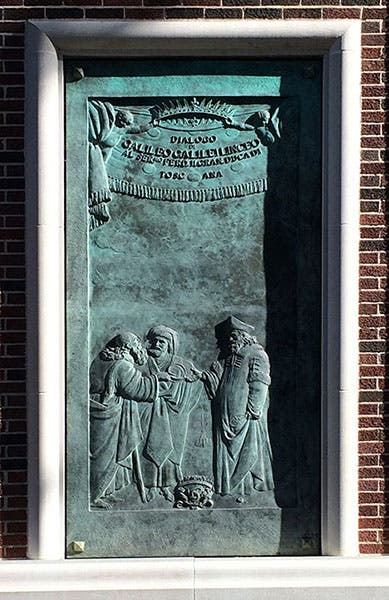
Bronze panel no. 4, based on the engraved frontispiece of Dialogo, by Galileo Galilei, with Aristotle, Ptolemy, and Copernicus in conversation; cast by Bruno Bearzi, 1967, west exterior annex wall, Linda Hall Library
Both of these initial panels, intended for the north (entrance-facing) wall of the new library annex, were enthusiastically received by the trustees, and a go-ahead was given for the remaining panels. Unfortunately, the Florentine floods intervened, which diverted Bearzi’s attention, and production had to be moved to a foundry in Milan, although Bearzi remained in charge. The final four panels were completed in late 1966, with two installed in niches on the west exterior walls of the annex, and two on the south wall. The two on the west wall were based on two books by Galileo, the first on his Assayer (1623), which asserts that the Book of Nature is written in the language of mathematics, with Galileo’s telescopes added (third image); and the second showing the three figures – Aristotle, Ptolemy, and Copernicus – from the frontispiece of Galileo’s Dialogue on the Two Chief World Systems (1632; fourth image).

Bronze panel no. 5, based on an engraving by Sebastien Le Clerc of an imagined visit by Louis XIV to the Academie des Sciences in Paris (1676), cast by Bruno Bearzi, 1967, originally mounted on the south exterior annex wall, now in the auditorium, Linda Hall Library

Bronze panel no. 6, based on the title page of Issac Newton’s Principia (1687), with Newton’s reflecting telescope added, cast by Bruno Bearzi, 1967, originally mounted on the south exterior annex wall, now in the auditorium, Linda Hall Library
The final two panels commemorate the engraved frontispiece by Sebastian Le Clerc for the first publication of the French Academy of Sciences (1676), recording an imaginary visit of Louis XIV to the academy (fifth image); and Isaac Newton’s Principia (1687), with the addition of the reflecting telescope that Newton invented (sixth image). These were initially installed on the south wall of the exterior of the annex, facing the back lawn. When the annex was extended to the rear in the 1990s, these two panels had to be removed, and two unfortunate decisions were made: first, to move the panels inside, to the auditorium; and second, to remove the lovely green patina that Bearzi was famous for and give them a finish that matched the woodwork. I confess I was sick when I first saw them after refinishing. But they are what they are, and the casting is still magnificent, and they can be admired by many more people than their exterior counterparts. But still ... . I am very glad the other four panels remain in place, patina intact, exactly where they were installed in 1967. They were and are a unique addition to a unique library.
There must be many photos of Bearzi at work in various archives, especially in Florence, but the only one I can find online is on the website of the Nelson-Atkins Museum. It is small, but it does show Bearzi making casts of Ghiberti's doors in 1947. So we include it as our last image.
Many thanks to Bruce Bradley, former rare books librarian here, for sharing with me part of a chapter from a book he is writing on the history of the Linda Hall Library.
William B. Ashworth, Jr., Consultant for the History of Science, Linda Hall Library and Associate Professor emeritus, Department of History, University of Missouri-Kansas City. Comments or corrections are welcome; please direct to ashworthw@umkc.edu.



